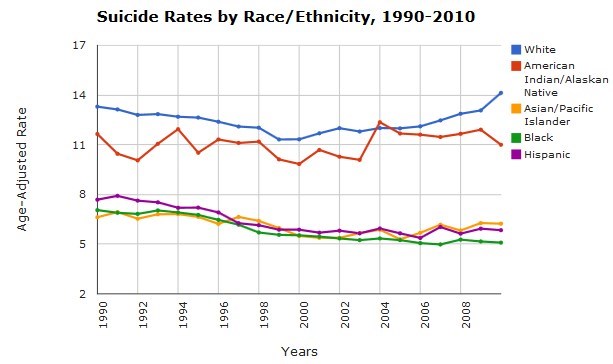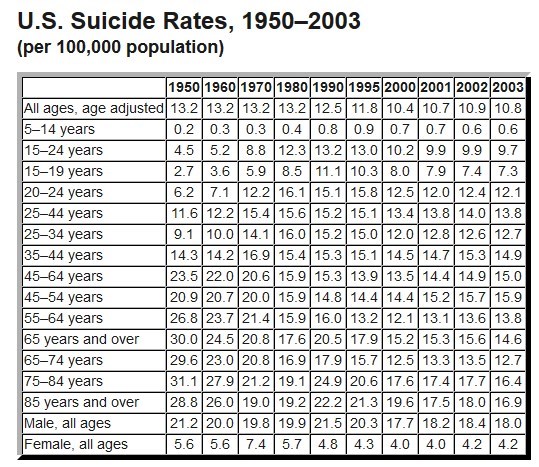Increased incidence of depression – perhaps due to lower vitamin D
Increasing prevalence of depression from 2000 to 2006
- Scand J Public Health December 2011 vol. 39 no. 8 857-863
- Depression is the leading cause of disability and is projected to become the second highest burden of disease (measured in disability-adjusted life years) by 2020
- Danes: The prevalence of The prevalence of major depressive disorder (MDD) increased from 2.0% to 4.9% during 2000–06
Global Depression Statistics Science Daily
July 26, 2011 — Depression affects 121 million people worldwide. In can affect a person's ability to work, form relationships, and destroy their quality of life. At its most severe depression can lead to suicide and is responsible for 850,000 deaths every year . New research published in BioMed Central's open access journal BMC Medicine compares social conditions with depression in 18 countries across the world.
In conjunction with the World Health Organization World Mental Health (WMH) Survey Initiative, researchers from 20 centers collaborated to investigate the prevalence of depression around the globe. To be classified as having had a Major Depressive Episode (MDE) a person was additionally required to fulfill five out of nine criteria including sadness, loss of interest or pleasure, feelings of guilt or low self-worth, disturbed sleep or appetite, low energy and poor concentration.
Based on detailed interviews with over 89,000 people, the results showed that 15% of the population from high-income countries (compared to 11% for low/middle-income countries) were likely to get depression over their lifetime with 5.5% having had depression in the last year. MDE were elevated in high-income countries (28% compared to 20%) and were especially high (over 30%) in France, the Netherlands, and America. The country with the lowest incidence was China at 12% but, in contrast, MDE were very common in India (at almost 36%).
Some aspects were cross cultural -- women were twice as likely to suffer depression as men and the loss of a partner, whether from death, divorce or separation, was a main contributing factor. However the contribution of age varied from country to country. Age of onset of depression was almost two years earlier in low income countries and, while the amount of difficulty a person had with aspects of their life increased with depression and how recent their last attack was, it was more apparent in people from high income countries.
Prof Evelyn Bromet from State University of New York at Stony Brook said, "This is the first study which uses a standardized method to compare depression and MDE across countries and cultures. We have shown that depression is a significant public-health concern across all regions of the world and is strongly linked to social conditions. Understanding the patterns and causes of depression can help global initiatives in reducing the impact of depression on individual lives and in reducing the burden to society.”
PDF is attached at the bottom of this page
Changes in the Prevalence of Major Depression and Comorbid Substance Use Disorders in the United States Between 1991–1992 and 2001–2002
- From 1991–1992 to 2001–2002, the prevalence of major depression among U.S. adults increased from 3.33% to 7.06%. Increases were statistically significant for whites, blacks, and Hispanics and for all age groups.
- PDF is attached at the bottom of this page
The increasing burden of depression 2006
- The mortality risk for suicide in depressed patients is more than 20-fold greater than in the general population.
- Worldwide projections by the World Health Organization for the year 2030 identify unipolar
- major depression as the leading cause of disease burden.
- PDF is attached at the bottom of this page
Depression is the 2nd largest cause of disability in seniors around the world

CLICK HERE for more information
Mental Health Disorders Now Leading Cause of Non-Fatal Illness Worldwide Mercola Sept 2013
one in 10 American adults report some form of depression.
Eleven percent of the US population over the age of 12 is on antidepressant medication.
2010 US government survey in which 1 in 10 American children was found to have attention-deficit/hyperactivity disorder (ADHD)—a 22 percent increase from 2003.
Suicide Epidemic Newsweek May 2013

Opposing data: suicide rate for US blacks is less than for whites
from American Society for Suicide Prevention
Reminder: Dark skinned people tend to have lower levels of vitamin D, so dark skinned African-Americans should have higher suicide rate than whites

More US veterans will soon have died of suicide than the names on the Vietnam wall
58,261 published Dec 2012
- Note Right now, if a person gets shot or blown up on the battlefield there is roughly a 90% chance they will make it home alive no matter how serious their injuries. . .
See also VitaminDWiki
99 percent of psychiatric population had less than 30 ng of vitamin D – June 2013
Low vitamin D and depression - Study and meta-analysis, April 2013
Every school shooter had used antidepression drugs, but how many were low on vitamin D
2X more likely to be depressed if low vitamin D (cohort studies) - Meta-analysis Jan 2013
Clinical Trials for Depression with vitamin D intervention 27 INTERVENTION trials listed as of Sept 2013
- Random controlled trials to see how much vitamin D is needed to reduce depression.
SAD rate 10X higher in cloudy Seattle than sunny Florida - April 2011
Diseases that may be related via low vitamin D which includes the following
Fewest Google searches for Mental Health when there is lots of vitamin D from the sun – May 2013
Hypothesis: Some Mental Illness could be treated or prevented with vitamin D many many articles
See also web
- Suicide Rates Rise Sharply in U.S. NYT May 2013
- From 1999 to 2010, the suicide rate among Americans ages 35 to 64 rose by nearly 30 percent
- Association between body mass index and suicide, and suicide attempt among british adults: The health improvement network database
- PubMed March 2013. inverse linear tendency between BMI and suicide
- Fierce Goodbye (a book with that title)
- In an average year there are 734,000 annual attempts in the US (estimated, no annual national data available).
- For every death by suicide, there are 25 attempts .
- Among youth, there are 100 to 200 attempts for every death - often used as a cry for help among the young.
Did Antidepressant Play a Role in Navy Yard Massacre? Scientific American, Sept 2013
Depression Life Extension - great overview with suggestions about supplements, such as Vitamin D and Magnesium, to decrease it
Depression vitamin D council: excellent
US Suicide Rates generally increasing during past 45 years for those under age 35 data from CDC

- Major depression is the psychiatric diagnosis most commonly associated with suicide
- about 20 times the risk found in the general population.
- * ((Top 10 health problems for women -ALL are associated with vitamin D depression is #1 health problem for women
Misc
- Suicide rates peak in the spring (when people have the lowest levels of vitamin D)
